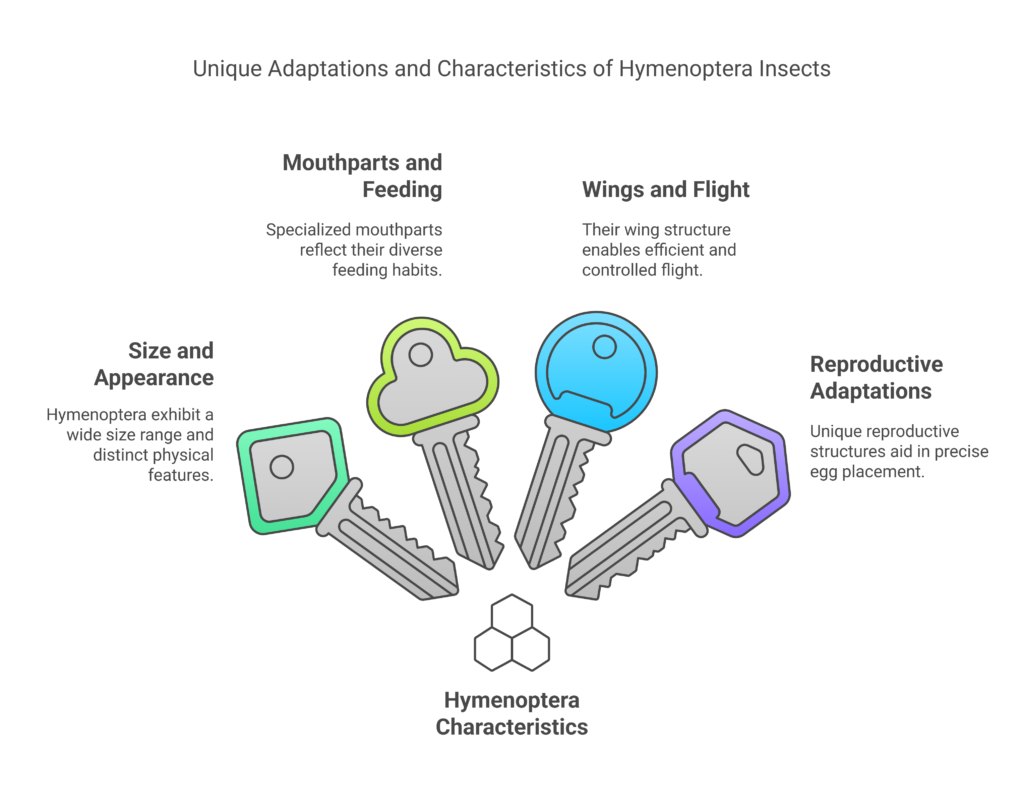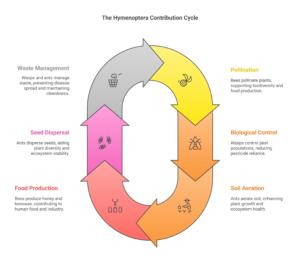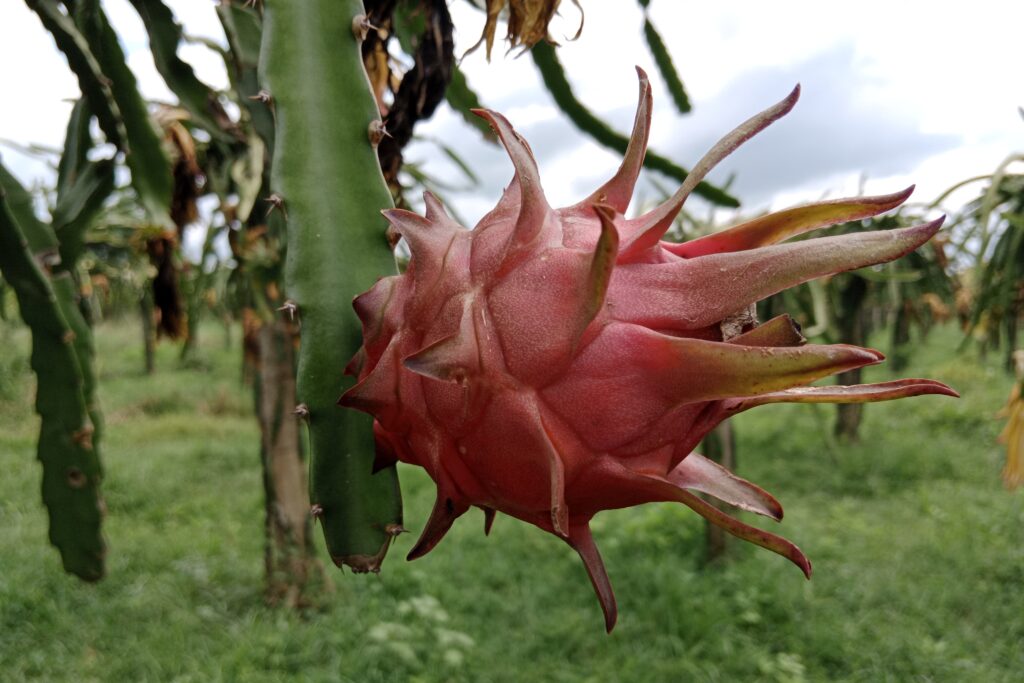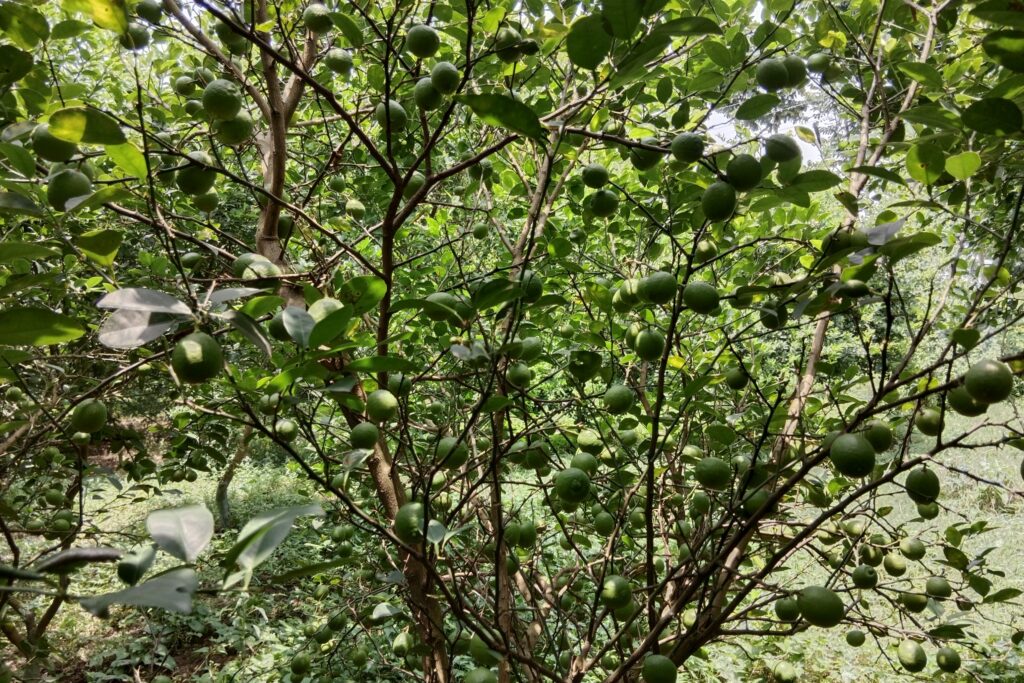Hymenoptera
The order Hymenoptera stands as one of the most diverse and ecologically significant groups of insects, boasting over 132,000 described species spread across 85 families. This remarkable order includes some of the most recognizable and impactful insects on the planet, such as bees, wasps, ants, and sawflies. Identification of Hymenoptera: Bees, Wasps, Ants, and Sawflies helps us to know about their values in our ecosystem. These creatures are not only fascinating in their behaviors and adaptations but also play indispensable roles in maintaining the balance of ecosystems.
From the vital pollination services provided by bees to the natural pest control offered by parasitic wasps, Hymenoptera are integral to both natural environments and human agriculture. Their complex social structures, diverse reproductive strategies, and wide range of lifestyles—from solitary to highly eusocial—make them a subject of endless intrigue for scientists and nature enthusiasts alike.
In this article, we will delve into the unique characteristics, incredible diversity, and profound ecological importance of Hymenoptera, shedding light on why these insects are so essential to life on Earth. Whether you’re an amateur naturalist or a seasoned entomologist, understanding the world of Hymenoptera offers a window into the intricate and interconnected web of life.
Characteristics of Hymenoptera
The order Hymenoptera differs from other insect orders due to a variety of distinctive morphological and behavioral characteristics. Their exceptional adaptability and ecological roles in a variety of settings are reflected in these traits.

1.Size and Appearance
Hymenoptera exhibit a vast size range and distinct physical features:
Size Variability
Species can range from as small as 0.2 mm (e.g., Mymarids, commonly known as fairy wasps) to as large as 40 mm (e.g., some hornets).
Body Structure
Their bodies are typically strongly sclerotized (hardened), giving them a robust and durable appearance. This exoskeleton often appears shiny or metallic, enhancing their visual appeal.
Hair Coverage
Many species have bodies covered with fine hairs, known as being hirsute, which can serve functions such as trapping pollen or aiding in thermoregulation.
2.Mouthparts and Feeding Habits
Hymenoptera possess highly specialized mouthparts that cater to their diverse feeding behaviors:
Chewing Mandibles
Adults have strong, flexible mandibles adapted for chewing. These are used for a variety of tasks, including cutting leaves, capturing prey, and constructing nests.
Lapping and Sucking
Their maxilla and labium are modified for lapping or sucking liquids, such as nectar or honeydew. This adaptation is especially prominent in pollinators like bees, enabling them to extract floral resources efficiently.
3.Wings and Flight Mechanisms
The wings of Hymenoptera are critical to their mobility and efficiency:
Wing Pairs
They possess two pairs of transparent, membranous wings. The forewings are larger than the hindwings.
Coupling Mechanism
These wings are coupled together by a series of tiny hooks, called hamuli, ensuring synchronized movement during flight. This adaptation allows for highly efficient and controlled flight, enabling behaviors such as hovering, swift maneuvers, and long-distance travel.
Wing Position at Rest
When not in use, the wings lie flat over the abdomen, contributing to the streamlined appearance of these insects.
4.Reproductive Adaptations
Reproductive structures in Hymenoptera exhibit remarkable specialization:
Ovipositor
Females are equipped with an ovipositor, a specialized organ for laying eggs. This structure enables precise egg placement, often within plant tissues, soil, or host organisms.
Sting Modification
In many species, the ovipositor has evolved into a sting. This adaptation serves as a defense mechanism and, in some cases, as a tool for paralyzing prey (e.g., in parasitic wasps).
Larvae and Reproduction in Hymenoptera
The larvae and reproductive strategies of Hymenoptera are as diverse as the species themselves, reflecting their broad ecological roles and adaptability to various environments.
Larval Morphology and Lifestyle
The larvae of Hymenoptera exhibit distinct morphological features and adaptations that align with their ecological niches:
i. Mouthparts
All Hymenopteran larvae possess mandibulate (chewing) mouthparts. These are well-suited for breaking down various food sources, whether plant material, other insects, or gall tissues.
ii. Dietary Diversity
Hymenopteran larvae display a wide range of feeding habits, depending on the species:
- Herbivorous Larvae: These feed on plant material, either externally (e.g., chewing leaves) or internally (e.g., mining within stems, leaves, or roots). Sawfly larvae are a prime example of external plant feeders, resembling caterpillars in their appearance and behavior.
- Entomophagous Larvae: Some larvae are predatory or parasitic, feeding on other insects. Parasitoid wasps, for instance, lay their eggs inside a host insect. The developing larvae consume the host from within, often killing it in the process.
- Gall-Forming Larvae: Certain species induce plants to form galls, which are abnormal growths that serve as both food and shelter for the larvae. These galls provide a protected environment, reducing predation risks and enhancing larval development.
Reproductive Adaptations
Hymenoptera exhibits fascinating reproductive strategies, many of which involve unique forms of parthenogenesis:
- Parthenogenesis
Many Hymenopteran species reproduce parthenogenetically, a process where offspring are produced without fertilization. This strategy allows rapid population expansion and is particularly advantageous in stable environments where genetic diversity may be less critical.
- Arrhenotoky
A specialized form of parthenogenesis observed in Hymenoptera, arrhenotoky involves the development of unfertilized eggs into males. This reproductive system is a hallmark of haplodiploidy, where:
- Females develop from fertilized eggs and are diploid (possessing two sets of chromosomes).
- Males develop from unfertilized eggs and are haploid (possessing a single set of chromosomes). This unique genetic system underpins the social structure of many Hymenopteran species, such as ants, bees, and wasps, influencing behaviors like colony organization and division of labor.
Ecological and Evolutionary Implications
Hymenoptera’s ecological success and evolutionary flexibility are greatly influenced by their varied larval morphologies and reproductive strategies:
i. Specialized Feeding Habits
By inhabiting different trophic niches (such as gall-forming, entomophagous, or herbivorous), hymenopteran larvae contribute significantly to ecosystems by altering plant dynamics or managing pest populations.
ii. Effective Reproduction
Arrhenotoky and parthenogenesis enable quick colony formation and reproduction, guaranteeing a species’ survival in shifting habitats.
Diversity of Hymenoptera
The order Hymenoptera is one of the most diverse insect groups, encompassing a wide array of species with varying ecological roles. It is broadly divided into two suborders: Symphyta (sawflies) and Apocrita (wasps, bees, and ants). These groups differ significantly in their morphology, behavior, and ecological functions.
1. Suborder Symphyta (Sawflies)
Symphyta represents the more primitive members of Hymenoptera and is characterized by the absence of the narrow “wasp-waist” that defines the Apocrita.
Key Characteristics
- Body Structure: Sawflies have a broad junction between the thorax and abdomen, distinguishing them from other Hymenopterans.
- Feeding Habits: Most sawflies are herbivorous, feeding on a variety of plants and trees. Their larvae often resemble caterpillars but can be distinguished by their proleg arrangement.
- Life Cycle: Sawfly larvae are typically external feeders, consuming leaves, stems, or wood.
Prominent Families and Their Roles
i. Pamphiliidae (Leaf-Rolling and Web-Spinning Sawflies)
These sawflies produce silk to roll or bind leaves together, creating shelters where larvae feed.
ii. Cephidae (Stem Sawflies)
Known for boring into plant stems, often causing damage to agricultural crops like cereals.
iii. Diprionidae (Conifer Sawflies)
This family specializes in feeding on coniferous trees, sometimes leading to defoliation and tree damage.
iv. Tenthredinidae (Common Sawflies)
The largest family within Symphyta, members are highly diverse and feed on a broad range of plants.
v. Siricidae (Horntails or Wood Wasps)
Larvae of these sawflies bore into wood, particularly dead or dying trees, and are often associated with fungal symbionts that aid in digestion.
Notable Species
i. Leaf-Rolling Rose Sawfly (Blennocampa pusilla)
Larvae roll rose leaves into tubes, feeding within. This activity can lead to premature leaf drying and drop, reducing plant vigor.
ii. European Apple Sawfly (Hoplocampa testudinea)
This species targets apple trees, with larvae tunneling under the skin of developing fruits, causing scarring and deformation. Infestations can significantly reduce fruit quality and yield.
Ecological Importance of Symphyta
Sawflies play diverse roles in ecosystems
- Plant-Feeding: While some species are pests, many contribute to plant pruning and nutrient cycling.
- Indicators of Ecosystem Health: The presence or absence of sawflies can indicate the health of specific plant communities or ecosystems.
- Forest Management Challenges: Certain species, such as the conifer sawflies, can become forest pests, necessitating monitoring and management in forestry practices.
2. Suborder Apocrita (Waist Wasps)
The suborder Apocrita represents an advanced group within Hymenoptera, characterized by a narrow “waist” or constriction between the thorax and abdomen, formed by the first abdominal segment (propodeum) and the petiole. This structural adaptation enhances mobility and precision in ovipositor use, making Apocrita highly versatile and ecologically significant. This suborder includes parasitic wasps, bees, ants, and social wasps.
i. Parasitic Wasps (Terebrantes)
Parasitic wasps are one of the most ecologically important groups within Apocrita. They are known for their ovipositors, which are often adapted for laying eggs inside or on other organisms. Many are parasitoids, meaning their larvae feed on and eventually kill the host. These wasps play a crucial role in natural ecosystems and agricultural pest management.
Key Families of Parasitic Wasps
a). Ichneumonidae (Ichneumon Wasps)
Large and diverse family, often targeting caterpillars and beetle larvae.
b). Braconidae (Braconid Wasps)
Parasitize a wide range of insects, including aphids and moth larvae.
c). Trichogrammatidae (Egg Parasitoids)
Tiny wasps, including Trichogramma species, specialize in parasitizing insect eggs, making them valuable for biological pest control.
d). Cynipidae (Gall Wasps)
Induce galls on plants for their larvae to develop, such as the Oak Gall Wasp and Rose Bedeguar Gall Wasp.
Notable Parasitoid-Host Relationships
a). Encarsia Formosa
Parasitizes whitefly larvae and is widely used in greenhouse pest control.
b). Aphidius species
Target aphids, offering a natural solution to aphid infestations.
c). Trichogramma species
Attack butterfly and moth eggs, significantly reducing pest populations.
Hyperparasitism
Some parasitic wasps are themselves parasitized by secondary parasitoids, a phenomenon known as hyperparasitism. While fascinating, this can sometimes undermine the effectiveness of biological pest control programs by reducing the population of primary parasitoids.
ii. Social Wasps, Bees, and Ants (Aculeata)
The Aculeata group of Apocrita includes species renowned for their complex social behaviors and ecological roles. These insects are distinguished by the modification of the ovipositor into a sting, used for defense and prey capture.
Key Superfamilies and Groups
a). Vespoidea (Social Wasps)
- Includes yellow jackets and hornets, which live in colonies with caste systems (queens, workers, and males).
- Social wasps are predators and scavengers, playing a role in controlling insect populations.
b). Apoidea (Bees and Bumblebees)
- Bees are vital pollinators, contributing significantly to agriculture and biodiversity.
- Honeybees (Apis mellifera) are well-known for their role in honey production and advanced colony organization.
- Bumblebees (Bombus species) are important pollinators of wildflowers and crops, particularly in cooler climates.
c). Formicoidea (Ants)
- Ants are among the most socially organized insects, with colonies exhibiting remarkable division of labor.
- Their ecological roles include soil aeration, seed dispersal, and predation on other insects.
Ecological Importance of Aculeata
a). Pollination: Many crops and other flowering plants depend on bees, especially honeybees and bumblebees, for pollination.
b). Predation and Scavenging: By feeding on insects and scavenging organic matter, social wasps manage pest populations.
c). Ecosystem Engineers: Ants improve plant development by influencing soil health through nutrient redistribution and tunneling.
Ecological and Economic Importance of Hymenoptera
The order Hymenoptera holds immense ecological and economic significance due to the diverse roles its members play in maintaining ecosystems and supporting human activities. Below is an expanded overview of their contributions:

1.Pollination
Bees, especially honeybees (Apis mellifera) and bumblebees (Bombus species), are some of the most effective and essential pollinators. Their pollination services are vital for the reproduction of flowering plants, which form the foundation of terrestrial ecosystems and global food production.
Ecological Contributions
- Pollination of wild plants supports biodiversity by facilitating the reproduction of countless species of flora, which in turn sustain diverse wildlife.
- Pollinators help maintain the genetic diversity of plant populations by transferring pollen across different plants.
Economic Impact
- The importance of bees to agriculture is demonstrated by the fact that pollinators are essential to the production of numerous fruits, vegetables, nuts, and seeds, such as apples, almonds, blueberries, and tomatoes. The annual global economic value of the pollination services that bees provide is estimated to be in the billions.
2. Biological Control
Parasitic wasps play a critical role in controlling populations of agricultural pests, providing a natural alternative to chemical pesticides.
Ecological Benefits
- Many parasitic wasps are parasitoids, meaning their larvae develop inside or on a host insect, eventually killing it. This behavior helps regulate pest populations in natural and agricultural systems.
Examples of Biological Control
- Trichogramma species: Tiny egg parasitoids widely used to control moth and butterfly pests in crops.
- Aphidius species: Parasitize aphids, which are major pests of crops like wheat, barley, and citrus.
- Encarsia formosa: Effectively controls whiteflies in greenhouse environments.
Economic Impact
- Reducing the reliance on chemical pesticides lowers costs for farmers and minimizes environmental damage, promoting sustainable agriculture.
3. Soil Aeration
Ants’ digging and burrowing practices improve the health of the soil.
Ecological Contributions
- Ant activity increases soil aeration, which facilitates deeper soil penetration of nutrients, water, and oxygen.
- Their tunneling improves soil fertility by redistributing nutrients and organic debris
Impact on Ecosystems
- Improved soil structure supports root growth and plant development, benefiting ecosystems and agricultural productivity.
4. Food Production
In addition to producing beeswax and other byproducts, honeybees are well known for producing honey, which is an important food source for humans.
Economic Contributions
- Honey is a globally consumed natural sweetener and is also used in traditional medicine, cosmetics, and food production.
- Beeswax has applications in candle-making, skincare products, and as a coating for food preservation.
Cultural Significance
Honey production has historical and cultural importance, with traditional beekeeping practices being a part of many societies worldwide.
5. Additional Contributions
Seed Dispersal
Some ants contribute to seed dispersal through a mutualistic relationship known as myrmecochory, where plants produce seeds with nutrient-rich appendages (elaiosomes) to attract ants.
Waste Management
Social wasps and ants act as scavengers, cleaning up organic waste and carcasses, which helps prevent the spread of disease.
Challenges and Conservation
Hymenoptera, vital to ecosystems, faces significant threats like habitat loss from urbanization and agriculture, harmful pesticide use, and the impacts of climate change, which disrupt resources and seasonal patterns. To protect these insects, especially pollinators, we need urgent actions such as creating pollinator-friendly habitats, reducing pesticide use, and adopting sustainable farming practices. Public awareness and education are crucial to inspiring conservation efforts, which are essential for preserving biodiversity and the vital ecosystem services these insects provide.
Conclusion
The directive in terms of form, function, and behavior, the Hymenoptera are an amazing group of insects. These insects, which range from the hardy honeybee to the cunning parasitic wasp, are essential to both human lives and ecosystems. We can endeavor to preserve these amazing animals for upcoming generations if we comprehend and value their jobs.
The world of Hymenoptera offers countless opportunities for amazement and discovery, regardless of your background—scientist, gardener, or just a nature lover. Therefore, the next time you witness an ant marching in a line or a bee buzzing around a flower, pause to admire the intricacy and beauty of these small but powerful creatures.



Pingback: Managing Potassium Deficiency in Maize -